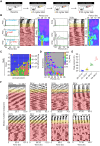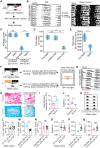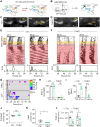Mesolimbic dopamine neurons drive infradian rhythms in sleep-wake and heightened activity state
- PMID: 39742489
- PMCID: PMC11694791
- DOI: 10.1126/sciadv.ado9965
Mesolimbic dopamine neurons drive infradian rhythms in sleep-wake and heightened activity state
Abstract
Infradian mood and sleep-wake rhythms with periods of 48 hours and beyond have been observed in patients with bipolar disorder (BD), which even persist in the absence of exogenous timing cues, indicating an endogenous origin. Here, we show that mice exposed to methamphetamine in drinking water develop infradian locomotor rhythms with periods of 48 hours and beyond which extend to sleep length and manic state-associated behaviors in support of a model for cycling in BD. The cycling capacity is abrogated upon genetic disruption of dopamine (DA) production in DA neurons of the ventral tegmental area (VTA) or ablation of nucleus accumbens projecting DA neurons. Furthermore, chemogenetic activation of VTADA neurons including those that project to the nucleus accumbens led to locomotor period lengthening in circadian clock-deficient mice, which was counteracted by antipsychotic treatment. Together, our findings argue that BD cycling relies on infradian rhythm generation that depends on mesolimbic DA neurons.
Figures








Update of
-
The neurons that drive infradian sleep-wake and mania-like behavioral rhythms.bioRxiv [Preprint]. 2023 Nov 16:2023.11.14.566955. doi: 10.1101/2023.11.14.566955. bioRxiv. 2023. Update in: Sci Adv. 2025 Jan 3;11(1):eado9965. doi: 10.1126/sciadv.ado9965. PMID: 38014299 Free PMC article. Updated. Preprint.
References
-
- Uchiyama M., Lockley S. W., Non-24-hour sleep-wake rhythm disorder in sighted and blind patients. Sleep Med. Clin. 10, 495–516 (2015). - PubMed
-
- Richter C. P., Two day cycles of alternating good and bad behavior in psychotic patients. Arch. Neurol. Psychiatry 39, 587–598 (1938).
-
- Wehr T. A., Goodwin F. K., Wirz-Justice A., Breitmaier J., Craig C., 48-hour sleep-wake cycles in manic-depressive illness: Naturalistic observations and sleep deprivation experiments. Arch. Gen. Psychiatry 39, 559–565 (1982). - PubMed
-
- Welsh D. K., Nino-Murcia G., Gander P. H., Keenan S., Dement W. C., Regular 48-hour cycling of sleep duration and mood in a 35-year-old woman: Use of lithium in time isolation. Biol. Psychiatry 21, 527–537 (1986). - PubMed
MeSH terms
Substances
Grants and funding
LinkOut - more resources
Full Text Sources
Other Literature Sources
Molecular Biology Databases

